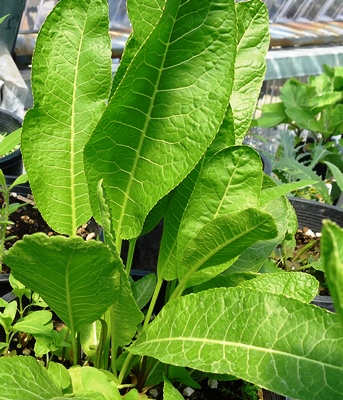
A member of the mustard family, horseradish (Armoracia rusticana) is a multi-purpose vegetable for the garden. This beautiful leafy plant has long, spiky edible leaves that make a fine addition to fresh salads. Long stems of white flowers bloom in mid-summer to add some extra interest in the garden.
But these plants have a thick, fleshy taproot system that’s the most useful part of the plant. Fresh horseradish makes some of the most flavorful condiments and sauces around.
If you plant horseradish, make sure you place it where you want it to stay. These perennial plants need a permanent planting space in full sun. Place transplants or root cuttings in the garden once the soil is dry enough to be worked.
As the horseradish plant grows, it sends out a number of fleshy lateral roots in the top 12 inches of the soil. The main root can also divide itself to grow more large roots.
Plants like a fertile and well-draining soil; however, go easy on the nitrogen to keep plants from overgrowing the garden.
When soil temperatures are about 60 degrees, start planting either root cuttings or transplants.
Plant root cuttings so the upper end of the horseradish cutting is 2-5 inches below the surface of the soil and at an angle, instead of straight up and down. Place root cuttings about 18-20 inches apart so plants have plenty of room to grow. Water in and keep the soil moist.
When planting horseradish transplants, dig a hole about twice as deep as the roots are long. Place the plant in the hole and refill with soil, keeping the base of the leaves at soil level. Leaves may wilt as a sign of transplant shock, so water in and provide some shade for around three days.
Add a layer of mulch like weed-free organic straw, untreated and dried grass clippings, crushed tree leaves or other organic mulch to cover the soil around plants.
Plants will establish quickly if soil is kept slightly moist. Avoid letting the soil dry out to keep roots growing long and straight.
If you amended the soil with enough compost at the beginning of the season, the plants may not need additional fertilizer. If you do need to fertilize, use an organic fertilizer (5-10-10).
Clip and prepare some of the leaves for eating, but wait until fall to harvest some roots. After leaves wilt at the first frost, carefully lift roots with a garden fork. Dig a few roots, and leave others in place.
Transform fresh horseradish into a sturdy condiment that stands up to hearty dishes. Fill jars and keep refrigerated and save a few to give as tasty holiday gifts.


















Comments
Log in or create an account to post a comment.
Sign up Log in